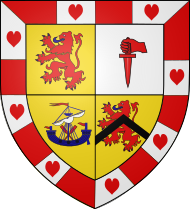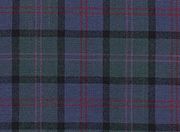| Chief | Name | Dates | Notes |
|---|
| 1st | Thomas (Tomaidh Mòr) | 15th century | Seated at the Thom, East bank of the Shee Water. |
| 2nd | John MacThomaidh of the Thom | Early 16th century | Son or Grandson of Tomaidh Mòr. |
| 3rd | Adam MacThomaidh of the Thom | mid-16th century | Son of John. |
| 4th | Robert MacThomaidh of the Thom | Murdered 1600 | The Thom was lost when his only daughter married a Farquharson. |
| 5th | John McComie of Finegand | 1600–1610 | Robert's brother; moved seat to Finegand. |
| 6th | Alexander McComie of Finegand [4] | 1610–1637 | Married a Farquaharson and gained more land at Benzian Mor in Glenshee. |
| 7th | John McComie (Iain Mor) | 1637–1676 | Alexander's son; known as "McComie Mòr", greatly expanded territory and prestige of the clan; acquired lands and Barony of Forter in Glenisla (1651); [5] [6] rose to support Montrose in 1644 [7] [8] |
| 8th | James McComie | 1674–1676 | 3rd son of Iain Mor. |
| 9th | Thomas McComie | 1676–1684 | 5th son of Iain Mor. |
| 10th | Angus Thomas | 1684–1708 | Aka "Mr. Angus" educated at St. Andrew University, Fife; 6th son of Iain Mòr, anglicized surname, (dejure Chief). |
| 11th | Robert Thomas | 1708–1740 | Large estate at Cullarnie, later moved to Belhelvie; son of Angus, (dejure). |
| 12th | David Thomas of Belhelvie | 1740–1751 | Eldest son of Robert. Died Young. |
| 13th | Henry Thomas of Belhelvie | 1751–1797 | Second son of Robert. Continued to farm at Belhelvie. |
| 14th | William Thoms | 1797–1843 | Eldest son of Henry, became a merchant in St. Andrews, further Anglicized surname, died with no children. |
| 15th | Patrick Hunter MacThomas Thoms | 1843–1870 | Son of George Thoms (a son of Henry and half-brother of William). Provost of Dundee. Purchased estate of Aberlemno in Angus. |
| 16th | George Hunter MacThomas Thoms | 1870–1903 | Son of Patrick; Sheriff of Caithness, Orkney and Shetland. Bequeathed his vast fortune and lands to St. Magnus Cathedral in Kirkwall. |
| 17th | Alfred MacThomas Thoms | 1903–1958 | Writer to the Signet. |
| 18th | Patrick MacThomas of Finegand | 1958–1970 | Great-grandnephew of Patrick, the first Chief known to be officially recognized by the Lyon Court since Thomas McComie in 1676. Army Officer. Married a 3rd cousin of Her Majesty the Queen. |
| 19th | Andrew MacThomas of Finegand (MacThomaidh Mòr) | 1970-date | Current Clan Chief, Retired Banker. |



